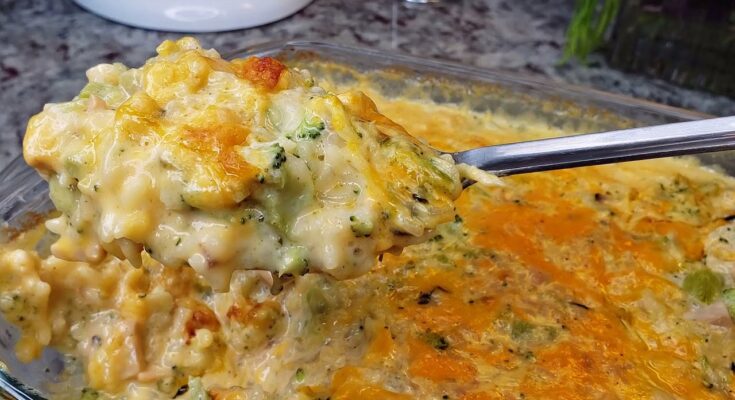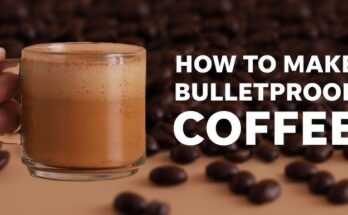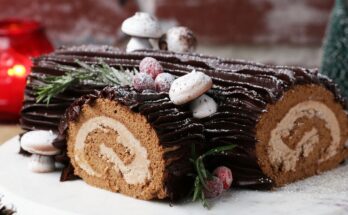Broccoli Cheese Casserole Recipe: There’s something magical about a warm, creamy, cheesy dish that just makes you feel at home, and the broccoli cheese casserole is exactly that. It’s a comfort food classic that never goes out of style. This beloved casserole has earned its spot on holiday dinner tables and weeknight menus alike thanks to its simple ingredients, mouthwatering taste, and hearty texture. Whether you’re feeding a picky toddler, a crowd of guests, or just yourself after a long day, this dish hits the spot every time.
Why do people keep coming back to this particular casserole? It’s because it strikes the perfect balance between indulgence and wholesomeness. The gooey cheese, the soft yet firm broccoli, and that golden top layer that adds just the right amount of crunch — it’s a combination that simply works. Plus, it’s highly customizable and can be made ahead of time, which makes life easier for busy cooks everywhere.
A Perfect Blend of Comfort and Nutrition
While the word “casserole” often brings to mind carb-heavy dishes, broccoli cheese casserole offers a nice compromise. It’s packed with broccoli, which is rich in fiber, vitamins C and K, iron, and potassium. When paired with a rich cheese sauce, it transforms into something that feels indulgent while still delivering nutrients. You get the satisfaction of a creamy, cheesy meal without completely throwing your health goals out the window.
And if you’ve ever struggled to get your kids to eat more greens, this recipe might be your new best friend. Cheese has a magical way of making vegetables more appealing. Even those who swear they “don’t like broccoli” often find themselves going back for seconds of this dish.
Ingredients You’ll Need
Fresh and Pantry-Friendly Ingredients
Let’s talk ingredients. One of the best parts about this broccoli cheese casserole is how simple and budget-friendly it is. You probably already have most of what you need in your kitchen right now. Here’s the core ingredient list:
- Fresh broccoli florets (about 4 cups) – You can use frozen if you’re in a pinch, but fresh gives a better texture.
- Shredded cheddar cheese (2 cups) – Medium or sharp cheddar works great, but feel free to mix in Monterey Jack or mozzarella.
- Cream of mushroom or cream of chicken soup (1 can, about 10.5 oz) – Adds a savory base.
- Mayonnaise or sour cream (½ cup) – Helps to create that creamy texture.
- Eggs (2 large) – Acts as a binder.
- Salt and pepper – To taste.
- Crushed Ritz crackers or breadcrumbs (for topping) – Adds that signature golden crust.
- Butter (2 tablespoons, melted) – For mixing with the topping.
These ingredients create a dish that’s savory, satisfying, and full of creamy goodness. You’ll find yourself coming back to this base recipe again and again.
Optional Add-ins to Customize the Flavor
Want to level up your casserole game? Here are some fun variations you can try depending on your taste or dietary needs:
- Diced cooked chicken or turkey – Turn it into a full meal with protein.
- Cooked rice or quinoa – Add some grains to make it even heartier.
- Bacon bits – Everything’s better with bacon.
- Diced onions or sautéed mushrooms – Add depth and earthiness.
- Different cheeses – Mix cheddar with Gruyère, pepper jack, or Swiss for a new flavor profile.
The beauty of this dish is that it can be tweaked a dozen ways without losing its charm. It’s like a culinary chameleon — always delicious, always comforting.
Kitchen Tools Required
Essential Cooking Equipment
Before you dive into cooking, make sure you’ve got everything you need on hand. Here’s a simple checklist of kitchen tools for this recipe:
- Large mixing bowl – For combining ingredients.
- Medium saucepan – To prepare the cheese sauce if making from scratch.
- Cutting board and knife – For chopping broccoli and any other add-ins.
- Measuring cups and spoons – Accuracy matters in baking and casseroles.
- Whisk or spatula – To stir everything smoothly.
- 9×13 inch baking dish – The classic casserole size.
- Oven mitts – Safety first.
- Aluminum foil (optional) – To cover while baking if needed.
Having everything prepped and ready to go before you start assembling the casserole will make the whole process smoother and quicker. It’s all about mise en place — a fancy French term that just means “everything in its place.” Trust me, it’s a game changer when cooking.
Step-by-Step Preparation
Step 1: Preheat and Prepare
The first thing you’ll want to do is get your oven preheating to 350°F (175°C). While that’s heating up, go ahead and grease your 9×13-inch baking dish with a bit of butter or non-stick spray. This step ensures your casserole won’t stick and makes cleanup much easier later on.
While the oven is warming, start prepping your ingredients. If you’re using fresh broccoli, chop it into bite-sized florets. Rinse it well and let it drain. If you’re going the frozen route, make sure it’s thawed and drained to avoid a watery casserole.
Take your eggs out of the fridge so they can come to room temperature — they mix better that way. Also, shred your cheese if it isn’t pre-shredded. Freshly grated cheese melts better and doesn’t have the anti-caking agents that pre-packaged ones often include.
Step 2: Blanch the Broccoli
Blanching is a simple but important step when working with fresh broccoli. It helps to partially cook the broccoli while preserving its vibrant green color and crisp-tender texture. To do this, bring a large pot of water to a boil and add a generous pinch of salt. Drop in your broccoli florets and let them cook for just 2–3 minutes. They should be bright green and slightly tender, not mushy.
After blanching, immediately transfer the broccoli into a bowl of ice water to stop the cooking process. This technique is called “shocking” and helps maintain the perfect texture in the final casserole. Once the broccoli has cooled, drain it well and set it aside. You don’t want any extra moisture seeping into your casserole, or it could end up watery.
If you’re using frozen broccoli, you can skip blanching but still make sure it’s completely thawed and well-drained. You can press it between paper towels if necessary to remove excess water.
Step 3: Make the Cheese Sauce
Now let’s talk cheese sauce — the heart and soul of this dish. While you can rely on cream of mushroom soup and mayonnaise to do the heavy lifting, adding a simple homemade cheese sauce takes this casserole from good to unforgettable.
In a medium saucepan over medium heat, melt 2 tablespoons of butter. Once melted, whisk in 2 tablespoons of all-purpose flour to create a roux. Cook for about 1–2 minutes, whisking constantly to avoid burning. Slowly add 1 cup of milk (whole milk works best for richness), whisking as you pour to prevent lumps.
Once the sauce begins to thicken, reduce the heat to low and stir in 1½ cups of shredded cheddar cheese until melted and smooth. Add a pinch of salt, pepper, and optional seasonings like garlic powder or a dash of paprika for a bit of flair.
This sauce will be silky, cheesy, and totally irresistible. Once it’s done, remove it from the heat and set it aside to cool slightly. You’ll be mixing it with eggs soon, so it shouldn’t be piping hot.
Step 4: Mix It All Together
It’s finally time to bring all the goodness together. In a large mixing bowl, combine your blanched broccoli, cheese sauce, ½ cup of mayonnaise or sour cream, and 2 beaten eggs. Mix everything gently but thoroughly until the broccoli is evenly coated.
Next, fold in the remaining ½ cup of shredded cheese and any optional mix-ins you’re using like cooked chicken, rice, or bacon. Pour the mixture into your prepared baking dish and spread it out evenly.
In a small bowl, mix crushed Ritz crackers (about 1 cup) or breadcrumbs with 2 tablespoons of melted butter. Sprinkle this over the top of the casserole for that signature crunchy topping. You can even throw on a bit more shredded cheese if you want it extra cheesy.
Step 5: Bake to Perfection
Place the casserole dish in your preheated oven and bake uncovered for 30 to 35 minutes. You’ll know it’s done when the top is golden brown and the edges are bubbling. If the top starts browning too quickly, you can loosely cover it with foil halfway through.
Once baked, let it rest for about 5 to 10 minutes before serving. This allows the casserole to set up a bit, making it easier to slice and serve. And trust me, the wait is worth it — your kitchen will smell like heaven!
Whether you’re dishing it out as a main course or a side dish, this broccoli cheese casserole will steal the show every time. It’s the kind of recipe that gets handed down and requested again and again.
Tips for the Best Broccoli Cheese Casserole
Cheese Choices and Melting Tips
When it comes to cheese, quality and selection matter. Cheddar is the go-to choice because of its sharp flavor and excellent melting properties, but you don’t have to stop there. Monterey Jack, Colby, Gruyère, or even a spicy Pepper Jack can add layers of flavor.
Here are some cheese tips:
- Always grate your own cheese when possible. Pre-shredded cheese contains anti-caking agents that can affect the texture of your sauce.
- Combine cheeses for a more complex flavor. Try mixing sharp cheddar with mozzarella for stretchiness or Gruyère for a nutty finish.
- Avoid overcooking the cheese sauce. High heat can break the sauce and turn it grainy.
Avoiding a Watery Casserole
No one wants a soggy casserole. Here are key tips to keep it firm and satisfying:
- Drain broccoli thoroughly. After blanching or thawing frozen broccoli, press out excess water with paper towels.
- Avoid adding too much liquid. The cheese sauce should be thick, not runny.
- Let it rest. Once baked, allow the casserole to cool for a few minutes before slicing. This helps the ingredients firm up.
Storing and Reheating Leftovers
How to Keep It Fresh
Got leftovers? Lucky you! This casserole stores beautifully and tastes just as good the next day. To store, allow it to cool completely, then transfer it to an airtight container. It will stay fresh in the fridge for up to 4 days.
For longer storage, portion it into freezer-safe containers or wrap the whole casserole dish in plastic wrap and foil. It can be frozen for up to 2 months.
Reheating Without Losing Flavor
To reheat, place your desired portion in an oven-safe dish and warm it at 350°F for about 15–20 minutes. If it looks a bit dry, you can add a splash of milk or broth before heating. Microwaving works too — just cover loosely and heat in 30-second bursts until warmed through.
Variations of Broccoli Cheese Casserole
Low-Carb or Keto Version
Want to enjoy the creamy comfort of broccoli cheese casserole without the carbs? Good news — it’s super easy to make a low-carb or keto-friendly version. The key is to skip high-carb add-ins like rice, breadcrumbs, or flour-based thickeners and focus on high-fat, low-carb ingredients that still deliver big on flavor.
Here’s how to do it:
- Replace cream of mushroom soup with a keto alternative like a mix of heavy cream and cream cheese.
- Skip the crackers or breadcrumb topping and opt for crushed pork rinds or almond flour mixed with parmesan cheese and butter.
- Use full-fat cheese and dairy. This not only enhances flavor but also helps keep the dish keto-approved.
- Add cooked bacon or sausage. It boosts the fat content and turns it into a filling, low-carb meal.
This version is rich, satisfying, and totally guilt-free for anyone watching their carbs. It’s proof that comfort food doesn’t have to mean carb overload.
Kid-Friendly Twist
If you’re making this for kids, especially picky eaters, there are a few tricks to make it more appealing:
- Chop the broccoli smaller. Bite-sized pieces are less intimidating.
- Add a little extra cheese. Kids love that gooey, stretchy texture.
- Use mild cheeses. Avoid overly sharp or strong flavors like blue cheese.
- Stir in some cooked pasta or small shells. Suddenly, it’s like mac and cheese — but with a healthy twist!
Another fun idea? Bake the casserole in individual ramekins or muffin tins for “mini casseroles.” Kids love anything bite-sized and personal.
What to Serve With Broccoli Cheese Casserole
Pairing Ideas for a Full Meal
While broccoli cheese casserole is filling enough to stand alone, it also pairs wonderfully with a variety of sides and mains. Here are a few ideas to round out your meal:
Proteins:
- Roast chicken – Classic and complements the creaminess of the casserole.
- Grilled pork chops – A juicy, savory pairing.
- Baked salmon – The richness of the fish balances well with the cheesy flavors.
Carbs (if you want more):
- Garlic bread or dinner rolls – Perfect for scooping up that cheesy goodness.
- Mashed potatoes – Double comfort food combo!
- Rice pilaf – Adds a light and fluffy contrast.
Vegetables:
- Fresh salad with vinaigrette – Cuts through the richness of the casserole.
- Roasted carrots or Brussels sprouts – Adds a caramelized veggie note.
- Steamed green beans – Keep it simple and clean.
No matter what you pair it with, broccoli cheese casserole is a showstopper on any plate.
Nutritional Breakdown
Calories, Protein, and Key Nutrients
Here’s a rough breakdown of the nutritional content for a standard serving (about 1 cup) of broccoli cheese casserole. Keep in mind this can vary depending on your ingredients and add-ins.
| Nutrient | Approximate Value |
|---|---|
| Calories | 280–320 kcal |
| Protein | 12–15 grams |
| Total Fat | 20–25 grams |
| Saturated Fat | 10–12 grams |
| Carbohydrates | 8–12 grams |
| Fiber | 2–4 grams |
| Sugar | 3–5 grams |
| Sodium | 500–700 mg |
| Calcium | 15–20% DV |
| Vitamin C | 70–90% DV |
Key nutritional takeaways:
- High in calcium thanks to the cheese and broccoli combo.
- Great source of vitamin C from the broccoli.
- Protein-packed if you add meat or use higher-protein cheeses.
- Can be tailored to suit low-sodium or low-carb diets easily.
It’s a relatively balanced dish and a great way to sneak in more veggies without compromising on taste.
FAQs about Broccoli Cheese Casserole Recipe
Can I use frozen broccoli?
Absolutely. Just make sure it’s completely thawed and well-drained before using. Pat it dry with paper towels to prevent a watery casserole.
Can I make this casserole ahead of time?
Yes! You can assemble it up to a day in advance and refrigerate it. Just bake as instructed when you’re ready, adding a few extra minutes to the cook time if it’s straight from the fridge.
What cheeses work best?
Cheddar is classic, but you can use a mix of cheeses like Gruyère, mozzarella, or pepper jack for variety. Just avoid cheeses that don’t melt well, like feta or goat cheese.
Can I add protein like chicken?
Yes, cooked diced chicken, turkey, or even ham are fantastic additions that turn this casserole into a full meal.
Is it freezer-friendly?
Yes, it freezes well. Wrap it tightly with foil and freeze for up to 2 months. Thaw overnight in the fridge before reheating.
Final Thoughts
Broccoli cheese casserole is one of those magical recipes that never gets old. Whether you’re prepping it for a holiday spread, a potluck, or just a weeknight dinner, it always delivers. Its creamy texture, gooey cheese, and comforting flavors make it a reliable favorite that’s also incredibly easy to whip up.
What makes this dish even more special is its flexibility. You can dress it up or down, make it kid-friendly, keto-approved, or protein-packed — the possibilities are endless. Plus, it stores and reheats beautifully, making it perfect for meal prepping or enjoying leftovers that taste just as good, if not better, the next day.
So the next time you’re looking for a cozy, crowd-pleasing recipe that doesn’t require a culinary degree, give this broccoli cheese casserole a try. You might just find it becomes a staple in your kitchen like it has in countless homes around the world.



